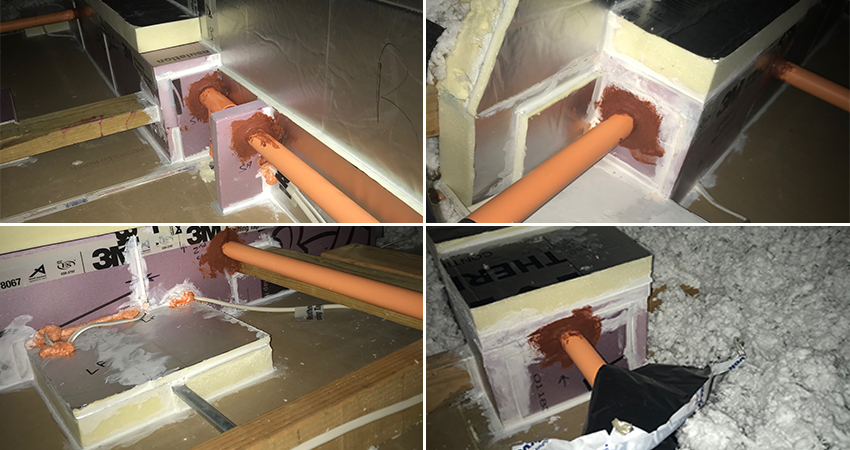With fire sprinkler systems becoming more common in single family housing, and builders becoming more aware of how important it is to build airtight homes, properly air sealing the heads becomes a prime concern. Fire sprinkler systems result in additional penetrations in the air barrier, whether the sprinkler heads are side wall or ceiling mounted. Because the internal house air pressure at the lid is amongst the highest air pressures in the home, and the source of much heat loss, this article will focus on air sealing sprinkler heads in accessible attics.
We know that the penetrations through the air barrier are going to be air sealed with either caulk, tape or foam. Here’s where some research into the fire sprinkler system is necessary in order to determine what materials to air seal with. There are a variety of materials used for fire sprinkler pipes and heads, all of which must pass industry test standards. Sprinkler lines may be steel pipe (sometimes called black iron), copper, PEX, or CPVC. CPVC (chlorinated polyvinyl chloride) pipe is recognized by its bright orange color. It’s critical that you understand what air sealing materials can be in contact with the fire sprinkler pipe specified. For instance, all air sealing materials can come into contact with steel pipe without any degradation to the steel pipe. CPVC is a plastic material that is sensitive to other chemicals. Because this is the fire sprinkler pipe we see most often we’ll focus on air sealing CPVC fire sprinkler pipe.
The air barrier for a fire sprinkler head must be created above the sprinkler head. The reason for this is the sprinkler is activated when hot air, from a fire in the house, rises up into the sprinkler head and triggers the head to drop down and water flow out. Never seal completely the sprinkler head penetration through the drywall. That might damage the sprinkler head and lead to malfunction. Therefore, an air sealed box must be built above the sprinkler head in the attic. Any air barrier material will do, as long as it is durable, rigid, and can be air sealed. Remember to completely air seal the box on all seams and the box to the drywall lid. These seams can be air sealed with any caulk, foam, or tape as long as it never touches the CPVC pipe. Leave a hole around the CPVC sprinkler pipe that exits the box, but make it is as small as possible because this will be air sealed with a manufacturer approved air sealing material. Researching major CPVC manufacturers sites (Lubrizol makes BlazeMaster and Spears makes FlameGuard) will lead you to lists they maintain of compatible products. These are products that the caulk, foam and tape manufacturers have submitted to the CPVC manufacturer to determine their effects on CPVC pipe.

Our industry has found out the hard way that, with regard to materials coming into contact with CPVC pipe, following the manufacturer’s installation instructions is critical. That’s because CPVC is an amorphous polymer, made up of long chain molecules. The plastic pipe fails when a solid in the polymer develops enough chain breaks or becomes disentangled. There is a range of effects a chemical (present in caulks, the adhesive on tapes, foams, etc) can have on CPVC plastic, from “always causes failure in every circumstance” to “zero effects in any circumstance.” Within this range prohibited chemicals may have some effect on the plastic, but typically outside mechanical stresses are needed to produce a failure. So, in addition to verifying the air sealing material of choice on the fire sprinkler manufactures website, it’s important to protect the lines from mechanical stress. Finally, an alternate method of constructing a tight lid while using fire sprinklers is to build a service channel above the ceiling that contains the fire sprinkler lines. The top of the service channel will be the air barrier, with insulation on top of it, thus becoming a thermal barrier. This strategy also allows for ducts and other mechanicals to be run inside the service channel. But, even if you don’t build air tight boxes above the sprinkler heads in the attic, you’ll still need to air seal the CPVC sprinkler lines as they run up through the house and into the attic, or service channel, and must be sealed at the bottom and top plates. Make sure you specify a system compatible air sealing product.
